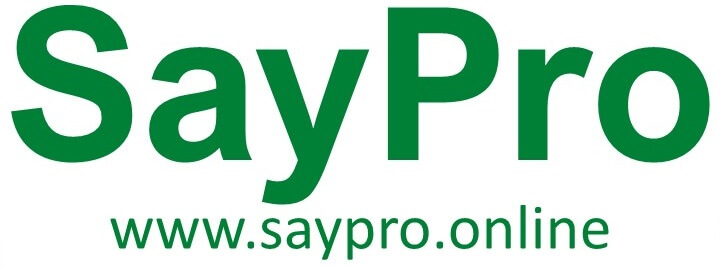Your basket is currently empty!

SayPro :Marketing Help Desk Training Course
R6 999,00
Description
SayPro :Marketing Help Desk Training Course
Module 1: Introduction to Help Desk Support
The Role of Customer Support in Marketing
Key Skills for Effective Customer Support
Module 2: Understanding Customer Needs
Identifying Customer Expectations
Managing Different Types of Customer Inquiries
Module 3: Communication Channels Overview
Chat Support: Best Practices & Tools
Email Support: Structure & Etiquette
Phone Support: Effective Communication Strategies
Module 4: Setting Up Help Desk Systems
Choosing the Right Help Desk Software
Integrating CRM with Help Desk Solutions
Module 5: Providing Efficient Customer Support
Response Time and Prioritization
Handling Difficult or Upset Customers
Managing Customer Expectations
Module 6: Managing Customer Inquiries via Chat
Writing Clear and Professional Messages
Using Automated Responses Effectively
Chat Support Best Practices for Quick Resolutions
Module 7: Email Support Excellence
Structuring Professional Emails
Crafting Clear, Concise, and Helpful Responses
Handling Multiple Email Queries at Once
Managing Negative or Complex Emails
Module 8: Phone Support Strategies
Building Rapport Over the Phone
Overcoming Communication Barriers
Handling Technical or Complex Inquiries
Call Management and Documentation
Module 9: Dealing with Common Customer Support Troubleshooting Common Issues
Providing Product Information and Updates
Handling Refunds, Returns, and Complaints
Module 10: Enhancing Customer Experience
Personalization Techniques in Support
Going Beyond Problem Solving: Creating a Positive Experience
Measuring Customer Satisfaction (CSAT) & Feedback
Module 1: Introduction to Help Desk Support
What is Help Desk Support?
In this lesson, we will introduce you to the concept of Help Desk Support, its role in customer service, and why it’s critical for the success of a business, especially in the marketing field.
Key Topics
- Definition and Purpose of Help Desk Support
- Types of Help Desk Support (Level 1, 2, and 3)
- How Help Desk Impacts Customer Retention and Satisfaction
- The Connection Between Customer Support and Marketing Success
The Role of Customer Support in Marketing
Customer support doesn’t just solve problems; it plays a direct role in customer loyalty and brand perception. In this section, you’ll learn about how Help Desk is intertwined with marketing strategies.
Key Topics
- The Role of Help Desk in Enhancing Customer Experience
- Customer Support as a Marketing Channel
- How Good Support Drives Word-of-Mouth Marketing
- Collecting Feedback for Marketing Improvements
Key Skills for Effective Customer Support
In this lesson, we focus on essential skills you need to develop to become an effective help desk professional. These skills will allow you to handle customer inquiries with professionalism and efficiency.
Key Topics
- Communication Skills (Clear, Concise, and Empathetic Communication)
- Problem-Solving and Critical Thinking
- Time Management and Multitasking
- Patience and Conflict Resolution
Tasks/Assignments
- Write a brief paragraph explaining the role of customer support in your favorite brand’s marketing strategy.
- Record a 1-minute video or voice memo practicing your tone for handling a customer complaint.
Quiz:
- What are the key differences between Level 1, Level 2, and Level 3 support?
- How can customer support influence brand loyalty?
Module 2: Understanding Customer Needs
Identifying Customer Expectations
Customer expectations shape the support experience. This lesson covers how to recognize customer expectations and how to meet or exceed them.
Key Topics
- What Are Customer Expectations?
- How to Understand and Manage Expectations
- Setting Realistic Expectations for Service
Active Listening Techniques
Active listening is crucial for understanding the underlying issues of a customer’s inquiry. Learn to listen not just to words, but also to tone, emotions, and context.
Key Topics
- What is Active Listening?
- Techniques for Active Listening
- How to Ask Probing Questions to Clarify Issues
- Avoiding Assumptions and Prejudices in Customer Conversations
Managing Different Types of Customer Inquiries
Every customer interaction is unique. This section will cover the strategies to handle different types of inquiries effectively, from general queries to urgent issues.
Key Topics
- Types of Customer Inquiries (General, Urgent, Technical, Emotional)
- How to Categorize Inquiries and Prioritize Responses
- Dealing with Multiple Inquiries at Once
Tasks/Assignments:
- List common customer expectations for a business or brand you are familiar with.
- Practice active listening with a friend or colleague by having them explain an issue while you practice clarifying questions.
Quiz:
- What is active listening, and why is it crucial in customer support?
- How do you prioritize an urgent customer inquiry over a general inquiry?
Module 3: Communication Channels Overview
Chat Support: Best Practices & Tools
Learn the nuances of providing support via live chat, including tools that facilitate chat communication and the dos and don’ts for maintaining a professional tone.
Key Topics
- Chat Support Tools and Software (e.g., Zendesk, Intercom)
- Speed and Efficiency in Chat Support
- Etiquette in Chat Support (e.g., use of emojis, tone, length)
- Handling Multiple Chats Simultaneously
Email Support: Structure & Etiquette
Email support requires different approaches than phone or chat support. In this lesson, we’ll dive into structuring professional emails, managing expectations, and handling inquiries through email.
Key Topics
- Email Support Best Practices
- Structuring Professional Emails (Subject, Body, Closing)
- Writing Clear, Concise, and Empathetic Emails
- Handling Negative or Complex Emails
Phone Support: Effective Communication Strategies
Phone support remains one of the most personal ways to interact with customers. This lesson will teach you how to communicate effectively over the phone to resolve issues quickly and professionally.
Key Topics
- Building Rapport Over the Phone
- How to Stay Calm and Professional During Challenging Calls
- Using Positive Language
- Documenting Conversations for Follow-up
Tasks/Assignments:
- Set up a mock live chat and respond to a series of simulated customer inquiries.
- Write a professional response to a customer complaint received via email.
- Conduct a role-play with a colleague or friend simulating a phone support call.
Quiz:
- What is one key difference between handling support via email and chat?
- What are two important factors to remember when managing a support call over the phone?
Module 4: Setting Up Help Desk Systems
Choosing the Right Help Desk Software
Selecting the appropriate software is essential for efficiently managing support requests. In this module, we’ll walk through the process of choosing and using Help Desk software.
Key Topics
- Overview of Popular Help Desk Software (Zendesk, Freshdesk, etc.)
- Features to Look for in Help Desk Software
- Integration with Marketing Platforms (CRM, Email Campaigns)
Ticketing System Basics
A ticketing system organizes and prioritizes customer inquiries. Learn how ticketing systems work and how to use them effectively to streamline your support efforts.
Key Topics
- The Ticket Lifecycle (Creation, Categorization, Resolution, Closure)
- How to Assign, Prioritize, and Escalate Tickets
- Best Practices for Organizing and Managing Tickets
Integrating CRM with Help Desk Solutions
Integrating customer relationship management (CRM) systems with help desk software can greatly enhance your ability to provide personalized, efficient service. This section covers best practices.
Key Topics
- Benefits of Integrating CRM with Help Desk Software
- How CRM Data Helps in Personalized Support
- Popular CRMs that Integrate with Help Desk Solutions
Tasks/Assignments:
- Research and select a Help Desk software tool you would recommend for a company and write a brief justification for your choice.
- Set up a ticketing system for a mock business and categorize incoming tickets.
Quiz:
- Why is it important to integrate CRM with Help Desk software?
- What is the lifecycle of a support ticket in a Help Desk system?
Module 5: Providing Efficient Customer Support
Response Time and Prioritization
Providing timely support is crucial in a help desk role. Learn how to manage response time and effectively prioritize customer inquiries.
Key Topics
- Importance of Response Time in Customer Satisfaction
- How to Set Response Time Expectations
- Methods for Prioritizing Inquiries Based on Urgency
Problem-Solving Techniques
Efficient problem-solving ensures that you can resolve customer issues quickly. This section will teach you key problem-solving methods.
Key Topics
- Steps for Effective Problem Solving
- Troubleshooting Common Customer Issues
- Using Knowledge Bases to Solve Problems Quickly
Handling Difficult or Upset Customers
Dealing with angry or frustrated customers is a core part of customer support. This lesson offers strategies for calming upset customers and resolving issues.
Key Topics
- Techniques for Calming Angry Customers
- Empathy and Active Listening in Conflict Resolution
- When to Escalate a Customer Issue
Managing Customer Expectations
Setting realistic expectations around response time, resolutions, and support limitations is crucial. In this lesson, you’ll learn how to effectively manage and meet customer expectations.
Key Topics
- The Importance of Transparency
- How to Set Realistic Expectations for Resolution Times
- Communicating Delays and Offering Alternatives
Tasks/Assignments:
- Role-play with a colleague to handle an upset customer scenario, focusing on calming techniques.
- Write a script for a support email response where you manage the customer’s expectations about a delay.
Quiz:
- What is the key to effectively managing response time?
- How can you de-escalate a conversation with an upset customer?
Module 6: Managing Customer Inquiries via Chat
Writing Clear and Professional Messages
Effective communication in chat is essential for quick and accurate resolution of customer issues. This lesson focuses on how to write clear, professional, and empathetic messages that guide customers through solutions.
Key Topics
- Writing Short and Concise Responses
- Using Professional Language and Tone
- Balancing Formality and Friendliness in Chat
- Acknowledging Customer Feelings and Providing Reassurance
Using Automated Responses Effectively
Automated responses can save time and streamline chat support. This lesson explains when and how to use automated replies, while ensuring the customer feels heard and supported.
Key Topics
- Types of Automated Responses (FAQs, Greetings, Waiting Times)
- Personalizing Automated Messages
- When to Escalate to a Human Agent
- Best Practices for Using Automation without Losing the Human Touch
Chat Support Best Practices for Quick Resolutions
Customers expect quick solutions. In this lesson, you’ll learn how to provide rapid, accurate solutions in a live chat environment.
Key Topics
- Tools and Shortcuts to Speed Up Responses
- How to Manage Multiple Chats Simultaneously
- Keeping the Customer Engaged While Awaiting a Solution
- Ensuring Accuracy in Quick Responses
Tasks/Assignments:
- Set up a mock chat conversation with a colleague or friend, practicing clear communication and empathy.
- Create an automated response for a frequently asked question relevant to your business or brand.
Quiz:
- What are two key elements to maintain in a professional chat response?
- When should you use automated responses in a live chat environment?
Module 7: Email Support Excellence
Structuring Professional Emails
Email communication in customer support requires a structured and professional approach. This lesson teaches how to write effective email responses that leave a positive impression.
Key Topics
- Key Parts of an Email (Subject, Body, Signature)
- Tone and Language: Keeping it Professional and Polite
- How to Ask Clarifying Questions in Emails
- Closing Emails Effectively
Crafting Clear, Concise, and Helpful Responses
Customers may have complex questions, but it’s important to respond with clarity and brevity. This lesson focuses on strategies to provide easy-to-understand answers.
Key Topics
- Writing Short and Direct Responses
- How to Break Down Complex Solutions
- Offering Links to Additional Resources (FAQ, Knowledge Base)
- Ensuring the Customer Fully Understands the Solution
Handling Multiple Email Queries at Once
Handling multiple emails can be overwhelming. This section teaches you how to prioritize and manage email queries effectively.
Key Topics
- Email Management Tools (Labels, Folders, Filters)
- Organizing Emails Based on Priority
- Setting Up Templates for Common Issues
- Following Up Without Overwhelming the Customer
Managing Negative or Complex Emails
Dealing with complaints or complex issues via email requires additional care. In this lesson, you’ll learn techniques for handling difficult emails professionally.
Key Topics
- How to Respond to Negative or Emotional Emails
- Offering Solutions and Managing Expectations in Email
- Turning a Negative Experience into a Positive Outcome
- Escalating Complex Issues to the Right Department
Tasks/Assignments:
- Write an email response to a customer who has requested a refund, focusing on clarity and professionalism.
- Manage a mock scenario where you respond to multiple email queries about a product issue, prioritizing responses.
Quiz:
- What is the most important aspect of a professional email in customer support?
- How can you manage multiple email queries effectively
Module 8: Phone Support Strategies
Building Rapport Over the Phone
Phone interactions are often more personal than chats or emails, so building rapport is key. In this section, you’ll learn strategies to establish trust and maintain a positive conversation.
Key Topics
- Greeting Customers Professionally
- Building Trust Through Active Listening and Empathy
- Using Positive Language to Set the Tone
- Personalizing the Conversation (Using the Customer’s Name)
Overcoming Communication Barriers
Sometimes, customers may have difficulty expressing themselves, or there might be a language or cultural barrier. Learn strategies to overcome these challenges and communicate effectively.
Key Topics
- Identifying Communication Barriers
- Active Listening to Overcome Ambiguities
- Asking Clarifying Questions
- Using Simple Language to Avoid Misunderstanding
Handling Technical or Complex Inquiries
Some customers will call with technical issues or complex inquiries that require more in-depth support. This lesson covers how to handle these calls efficiently.
Key Topics
- Asking the Right Questions to Diagnose Technical Problems
- Using Troubleshooting Scripts and Guides
- How to Remain Calm When You Don’t Know the Answer
- Escalating Complex Issues to Higher-Level Support
Call Management and Documentation
Efficient call management helps prevent confusion and ensures proper follow-up. In this section, we’ll discuss how to document calls and effectively manage your queue.
Key Topics
- Proper Call Documentation
- Keeping Notes on Customer Issues and Solutions
- How to Transfer Calls or Escalate Issues
- Closing Calls on a Positive Note
Tasks/Assignments:
- Practice a mock phone call with a colleague, focusing on building rapport and active listening.
- Create a troubleshooting guide or script for a hypothetical technical issue.
Quiz:
- Why is it important to build rapport over the phone?
- What strategies can you use to overcome communication barriers with customers?
Module 9: Dealing with Common Customer Support Troubleshooting Common Issues
Learn to resolve frequent customer issues by using step-by-step solutions. Troubleshooting is an essential skill in help desk support, and this section will help you manage the most common problems efficiently.
Key Topics
- Common Customer Issues and Solutions (Login Issues, Payment Problems, etc.)
- Using Knowledge Bases for Self-Support
- Troubleshooting Techniques for Technical Problems
Providing Product Information and Updates
Sometimes, customers just need clarification on products, services, or updates. This lesson teaches how to provide clear and accurate information.
Key Topics
- How to Communicate Product Features and Benefits
- Handling Questions About Product Availability or Updates
- Using Knowledge Management Systems for Up-to-Date Information
Handling Refunds, Returns, and Complaints
Refunds and returns are common in customer service. Learn how to handle complaints professionally while adhering to company policies.
Key Topics
- Company Policies on Refunds and Returns
- How to Communicate Refund Policies Effectively
- How to Handle Refund Requests in a Positive Way
Tasks/Assignments:
- Create a troubleshooting guide for a common technical issue related to your business.
- Write an email response for a customer requesting a product refund.
Quiz:
- What is the first step in troubleshooting a customer’s technical issue?
- How can you handle a refund request while maintaining customer satisfaction?
Module 10: Enhancing Customer Experience
Personalization Techniques in Support
Customers love feeling like they are treated as individuals, not just a number. In this section, you will learn how to personalize customer interactions in every communication channel.
Key Topics
- Using Customer Data to Personalize Interactions
- Referring to Previous Interactions for Continuity
- Using Customer’s Name and Preferences to Build Rapport
Going Beyond Problem Solving: Creating a Positive Experience
A good customer service experience is not just about solving problems—it’s about leaving customers satisfied and valued. Learn techniques to enhance the overall customer experience.
Key Topics
- How to Exceed Customer Expectations
- Creating Memorable Support Experiences
- Turning a Negative Experience into a Positive One
Measuring Customer Satisfaction (CSAT) & Feedback
Customer feedback is essential for improvement. This lesson covers the importance of measuring satisfaction and using that feedback to improve your support processes.
Key Topics
- How to Collect Customer Feedback (Surveys, Direct Questions)
- Interpreting Customer Satisfaction Metrics
- Using Feedback to Improve Help Desk Performance
Tasks/Assignments:
- Personalize a response for a customer based on their previous interaction history (create a mock scenario).
- Create a brief customer satisfaction survey based on your customer support experience.
Quiz:
- How can personalized support enhance the customer experience?
- What is CSAT, and why is it important?
–
You must be logged in to post a review.
Vendor Information
- No ratings found yet!
-
SayPro :Marketing Security Training Course
R5 999,00 Add to basket -
SayPro: Marketing Social Sharing Training Course
R4 999,00 Add to basket -
SayPro :Marketing Disaster Recovery Training Course
R5 999,00 Add to basket -
SayPro: Marketing Email Marketing Training Course
R5 999,00 Add to basket -
SayPro: Marketing Banner Ads Training Course
R4 999,00 Add to basket -
SayPro :Marketing Social Media Links Training Course
R4 999,00 Add to basket








Reviews
There are no reviews yet.